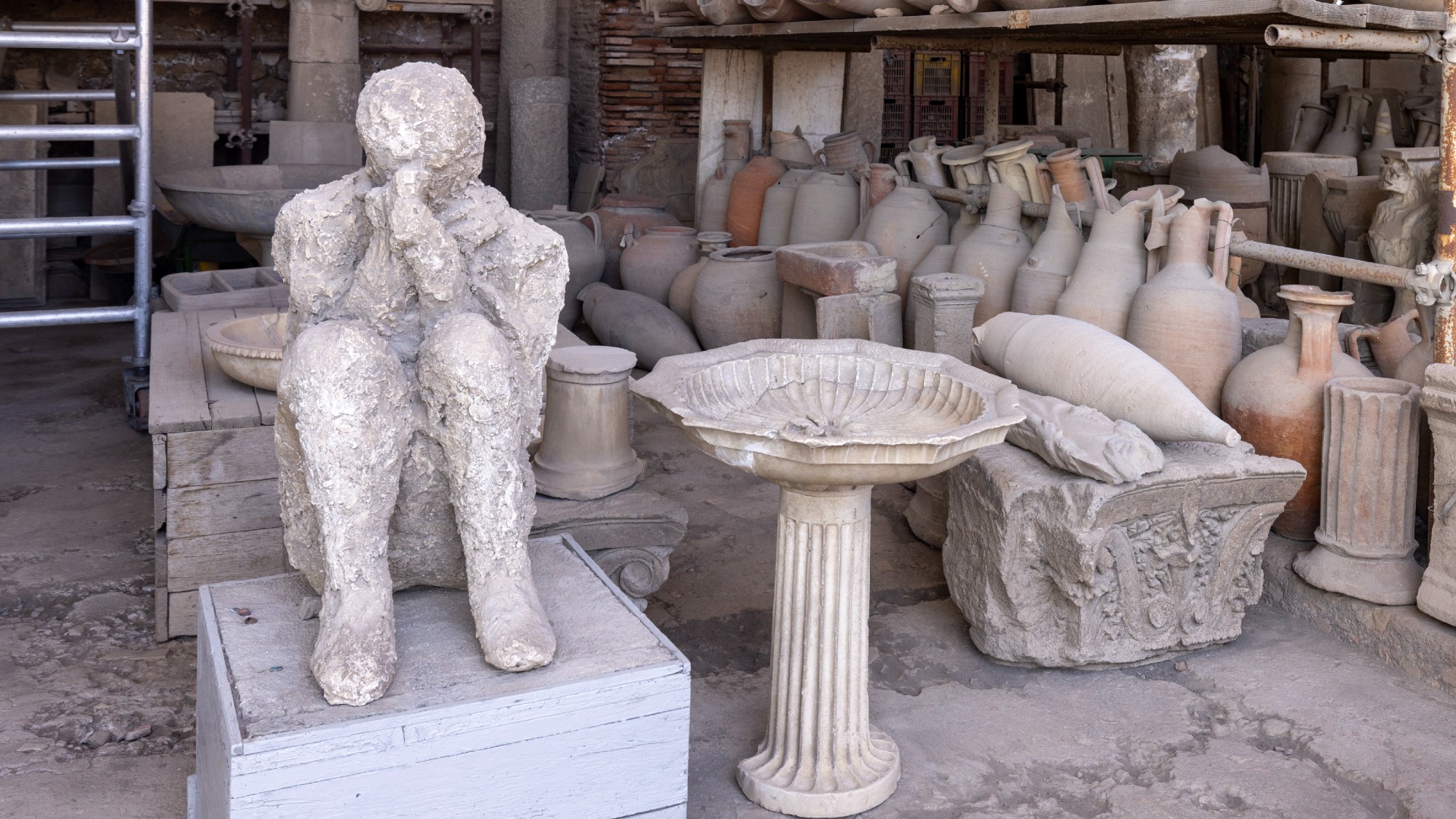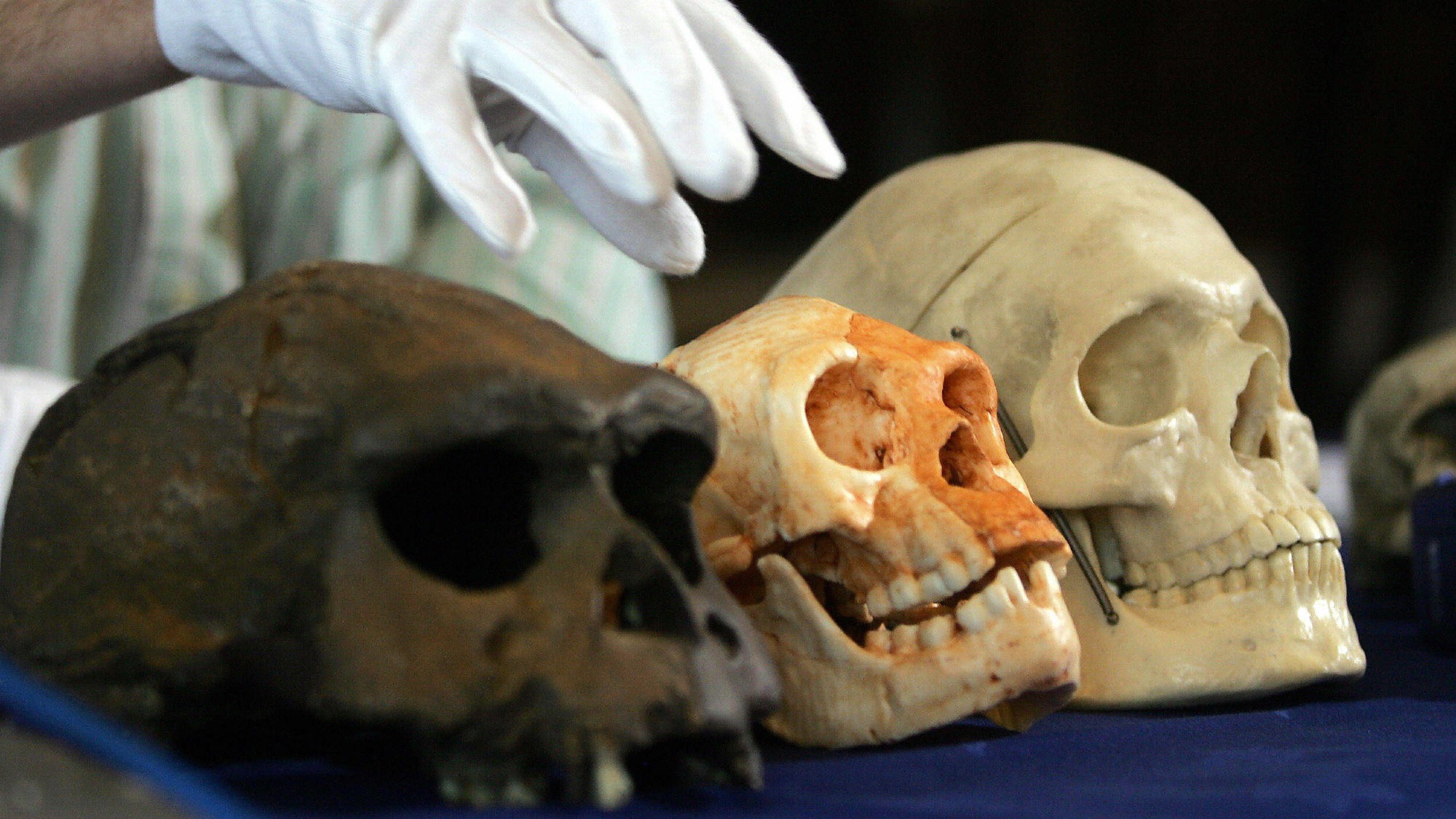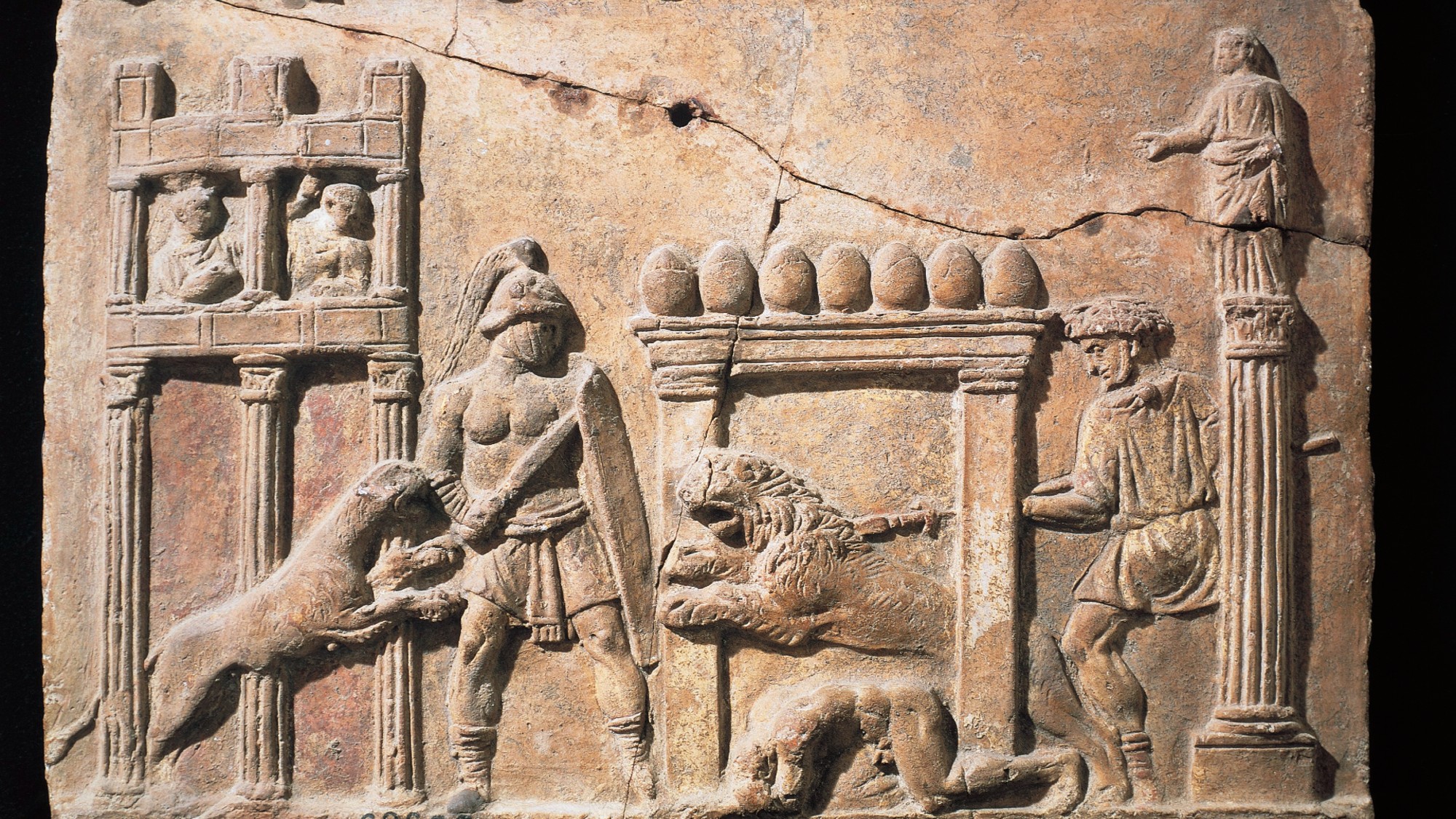The seven strangest historical discoveries made in 2025
From prehistoric sunscreen to a brain that turned to glass, we've learned some surprising new facts about human history

No matter how many books and TV documentaries are made appearing to give a definite account of life in ancient civilizations, the ongoing work of historians and archaeologists means that the story of the past is never finished. There are always new discoveries being made – here are seven of the most surprising.
Sunscreen's role in human history
A form of ancient sunscreen could have helped Homo sapiens survive a period of intense environmental stress that killed off the Neanderthals, scientists have suggested.
The two species existed alongside each other for millennia until about 40,000 years ago, when Neanderthals disappeared. The reason for their demise is not entirely clear, but one factor may have been the shift of the Earth's magnetic poles that occurred around that time. Known as Laschamps excursion, this phenomenon lasted 1,000 years and weakened Earth's magnetic field to about 10% of its current strength, leading to a massive increase in solar radiation.
The Week
Escape your echo chamber. Get the facts behind the news, plus analysis from multiple perspectives.

Sign up for The Week's Free Newsletters
From our morning news briefing to a weekly Good News Newsletter, get the best of The Week delivered directly to your inbox.
From our morning news briefing to a weekly Good News Newsletter, get the best of The Week delivered directly to your inbox.
Researchers in Michigan have found evidence that Homo sapiens developed what may have been protective strategies: they took shelter in caves and ramped up their extraction of the pigment ochre, perhaps because they were using it to paint their bodies. Needles and awls unearthed at Stone Age sites also indicate the use of tailored clothes – which would have kept them warmer too, enabling them to travel further for food. But there is little evidence that the Neanderthals adapted in such ways. Solar radiation can damage sight and lead to birth defects and infant deaths – so protection from it would "have conferred significant advantage", said Raven Garvey, who co-authored the study.
Vesuvius eruption "turned a brain to glass"
The eruption of Vesuvius almost 2,000 years ago buried Herculaneum and Pompeii under a thick layer of ash, which preserved everything from its residents to the frescoes in their villas. Numerous bodies have been excavated, but one is more unusual than most: that of a young man who was found lying in his bed – and whose brain appeared to have been turned to glass. When this was observed in 2020, such a phenomenon had never been seen before, and scientists were baffled as to how it could have occurred. Now a team have come up with a possible explanation.
For glass to have formed, the tissue would have had to have heated very rapidly until it liquefied, then cooled fast enough to prevent crystals forming as it solidified. Analysis of fragments of the man's brain has shown that it was heated to 510C, before fast-cooling. The pyroclastic flows from the volcano did not get that hot; nor would they have allowed for rapid cooling. However, the ash cloud that swept through the town first would have been far hotter. This heat, says the study, could have evaporated the water in the man's brain, causing it to explode into tiny pieces. The cloud would then have rapidly cleared, allowing the fragments to cool and vitrify.
The gruesome death of a gladiator
We think of gladiators being made to fight tigers, lions or bears as a staple of the Roman circus. But though the Romans wrote about such spectacles and depicted them in frescos and mosaics, there has never been any direct physical evidence for their existence – until now. Archaeologists have analysed wounds on the hip bone of a gladiator who died in England in the 3rd century AD, and concluded that their shape is "consistent" with the bite marks of large cats, with lions being the closest fit.
A free daily email with the biggest news stories of the day – and the best features from TheWeek.com
The skeleton was one of dozens unearthed 20 years ago in a cemetery in York. Most belonged to well-built young men, and had been decapitated; their bones bore marks of injuries inflicted by blades; one had been shackled; and DNA tests indicated that they came from all over the Roman empire. All of which led the team to conclude that they were gladiators. The researchers do not think that this gladiator was killed by the lion bite, however, but that he'd been injured already and was dragged off at the point of death – which "must have been absolutely terrifying", said Tim Thompson, one of the study's authors. Given the difficulty of transporting big cats, the find also underlines the importance of York in the Roman world.
Hunter-gatherers travelled by sea
Archaeologists have been startled to find evidence that humans lived on Malta some 8,500 years ago. The findings, published in Nature, mean that the seafaring abilities of hunter-gatherers must be rethought. Previously, it was assumed that journeys of such length across the Mediterranean only started following the invention of boats with sails.
The archaeologists, from the Max Planck Institute of Geoanthropology, believe that they arrived in dug-out canoes, having undertaken a journey in open water of at least 100km, some of which (given the limited speed of such vessels) must have been in darkness.
The island is so small and isolated, the presumption had been that it could not have sustained a population that wasn't growing its own food. But carbon dating of charcoal, found in hearths outside a cave complex in the north of the island, indicates that hunter-gatherers were there a millennium before farming became widespread. Other evidence at the site shows that these ancient people hunted meat, in the form of deer, birds and seals; they also cooked sea urchins, crab and fish.
Ancient Romans suffered from lead pollution
The Romans came into so much contact with lead – via everything from their paints to their coins, water pipes and drinking vessels – that historians have long speculated that lead poisoning could have hastened the fall of their empire. Now, a study has shown that there were also high levels of lead in the air they breathed – enough, in fact, to have affected brain development.
Romans' mining of lead and their smelting of lead ore to obtain silver would have released vast amounts of lead into the atmosphere. To gauge the scale of this, a team in the US analysed residues trapped in ice that formed between 500BC and AD600. Their findings indicate that levels of the neurotoxin in the air increased sharply in around 15BC, and remained high for two centuries. They then used atmospheric models to map the pollutants' spread, and modern health studies to assess its impact.
Their results showed that, at its peak, the lead pollution across Europe (believed to be the first widespread industrial pollution) was severe enough to cause a two-to three-point drop in IQ. That might not sound much, but, "when you apply [it] to essentially the entire European population, it's kind of a big deal", said co-author Nathan Chellman.
We sleep more than our ancestors
In our "always on" world, there is a feeling that no one is getting enough sleep; and that the time we spend staring at screens is preventing us from sleeping well. Yet according to recent research, we get more – and better – sleep than our ancestors in pre-industrial times are likely to have done.
For a study published in the Proceedings of the Royal Society B, scientists in Canada analysed data on the sleep patterns of 866 people in 54 sleep studies from around the world – from the residents of big cities to the members of hunter-gatherer tribes. They found that the participants living in industrial societies slept more, clocking up an average of 7.1 hours a night compared with just 6.4 in the less industrial societies.
And they also found there had been no significant decline in sleep in Westernised places over the past half-century. The study also revealed that people in these societies tend to get more efficient sleep – meaning they are asleep for more of the time they spend in bed (88% compared with 74%). The researchers suggest modern living conditions are simply more conducive to restful sleep: "We don't have to fend with rival human groups at night or predators," said David Samson.
But if that is the case, why then do so many people in the West seem to wake up feeling exhausted? This may be due to the study's other main finding, which is that people living in industrialised countries have a less regular circadian rhythm: their sleep patterns don't match the natural cycles of light and dark.
Iron Age women had real power
When the Romans invaded Britain, they found the natives strange, says The Times. Their warriors painted themselves blue; and they had moustaches – a concept so foreign to Romans, they had no name for it. Perhaps worst of all, Roman scribes recorded that Celtic rebellions against Roman rule were often led by women. This would have seemed outlandish in Rome, where women were legally owned by their fathers and their husbands, and had no role at all in public life.
But while the existence of female warriors such as Boudicca is not in doubt, historians have long distrusted these accounts, suspecting the extent of female power and influence was overstated, to make Celtic societies seem completely barbaric. Now, however, archaeologists at Trinity College Dublin and Bournemouth University have backed up the scribes' observations.
The research was based on the remains of 57 people unearthed at an Iron Age cemetery in Dorset. By tracing mitochondrial DNA (which is only passed on by women), the team established that most of the female members of this community were related and all descended from a single woman; by contrast, there was considerable diversity in the male Y chromosomes, suggesting that the men came from lots of different families.
This, the study says, indicates that men moved into their wives' community on marriage – a pattern known as matrilocality – perhaps because land and wealth passed down through the female line. The grave goods found back up this theory: the higher status items tended to have been buried with women.
-
 5 fairly vain cartoons about Vanity Fair’s interviews with Susie Wiles
5 fairly vain cartoons about Vanity Fair’s interviews with Susie WilesCartoon Artists take on demolition derby, alcoholic personality, and more
-
 Joanna Trollope: novelist who had a No. 1 bestseller with The Rector’s Wife
Joanna Trollope: novelist who had a No. 1 bestseller with The Rector’s WifeIn the Spotlight Trollope found fame with intelligent novels about the dramas and dilemmas of modern women
-
 Codeword: December 20, 2025
Codeword: December 20, 2025The daily codeword puzzle from The Week
-
 Homo floresiensis: Earth’s real-life ‘hobbits’
Homo floresiensis: Earth’s real-life ‘hobbits’Under the Radar New research suggests that ‘early human pioneers’ in Australia interbred with archaic species of hobbits at least 60,000 years ago
-
 Mendik Tepe: the ancient site rewriting human history
Mendik Tepe: the ancient site rewriting human historyUnder The Radar Excavations of Neolithic site in Turkey suggest human settlements more than 12,000 years ago
-
 Hitler: what can we learn from his DNA?
Hitler: what can we learn from his DNA?Talking Point Hitler’s DNA: Blueprint of a Dictator is the latest documentary to posthumously diagnose the dictator
-
 How did Kashmir end up largely under Indian control?
How did Kashmir end up largely under Indian control?The Explainer The bloody and intractable issue of Kashmir has flared up once again
-
 The fall of Saigon
The fall of SaigonThe Explainer Fifty years ago the US made its final, humiliating exit from Vietnam
-
 Scientists have found the first proof that ancient humans fought animals
Scientists have found the first proof that ancient humans fought animalsUnder the Radar A human skeleton definitively shows damage from a lion's bite
-
 When the U.S. invaded Canada
When the U.S. invaded CanadaFeature President Trump has talked of annexing our northern neighbor. We tried to do just that in the War of 1812.
-
 The assassination of Malcolm X
The assassination of Malcolm XThe Explainer The civil rights leader gave furious clarity to black anger in the 1960s, but like several of his contemporaries met with a violent end